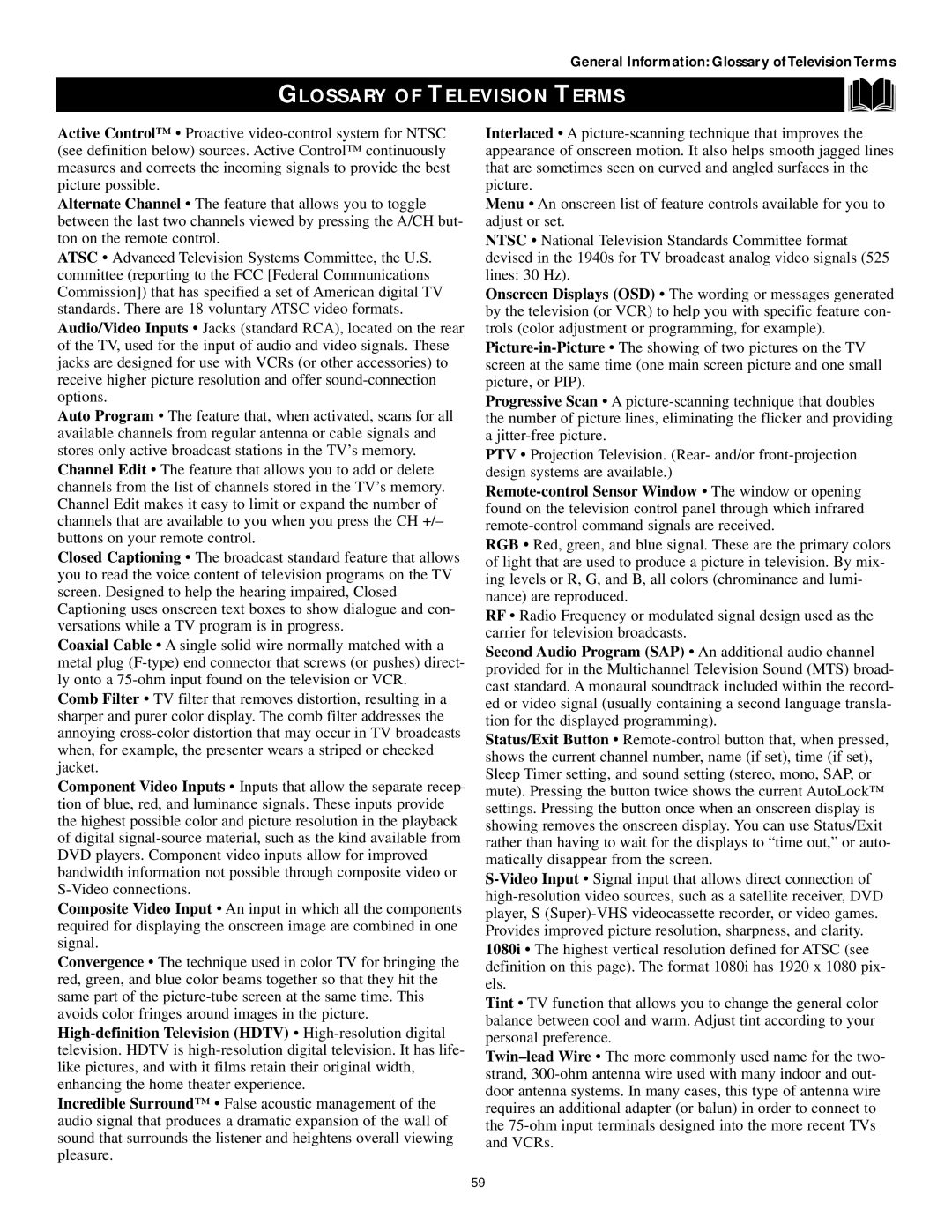Active Control™ • Proactive video-control system for NTSC (see definition below) sources. Active Control™ continuously measures and corrects the incoming signals to provide the best picture possible.
Alternate Channel • The feature that allows you to toggle between the last two channels viewed by pressing the A/CH but- ton on the remote control.
ATSC • Advanced Television Systems Committee, the U.S. committee (reporting to the FCC [Federal Communications Commission]) that has specified a set of American digital TV standards. There are 18 voluntary ATSC video formats. Audio/Video Inputs • Jacks (standard RCA), located on the rear of the TV, used for the input of audio and video signals. These jacks are designed for use with VCRs (or other accessories) to receive higher picture resolution and offer sound-connection options.
Auto Program • The feature that, when activated, scans for all available channels from regular antenna or cable signals and stores only active broadcast stations in the TV’s memory. Channel Edit • The feature that allows you to add or delete channels from the list of channels stored in the TV’s memory. Channel Edit makes it easy to limit or expand the number of channels that are available to you when you press the CH +/– buttons on your remote control.
Closed Captioning • The broadcast standard feature that allows you to read the voice content of television programs on the TV screen. Designed to help the hearing impaired, Closed Captioning uses onscreen text boxes to show dialogue and con- versations while a TV program is in progress.
Coaxial Cable • A single solid wire normally matched with a metal plug (F-type) end connector that screws (or pushes) direct- ly onto a 75-ohm input found on the television or VCR.
Comb Filter • TV filter that removes distortion, resulting in a sharper and purer color display. The comb filter addresses the annoying cross-color distortion that may occur in TV broadcasts when, for example, the presenter wears a striped or checked jacket.
Component Video Inputs • Inputs that allow the separate recep- tion of blue, red, and luminance signals. These inputs provide the highest possible color and picture resolution in the playback of digital signal-source material, such as the kind available from DVD players. Component video inputs allow for improved bandwidth information not possible through composite video or S-Video connections.
Composite Video Input • An input in which all the components required for displaying the onscreen image are combined in one signal.
Convergence • The technique used in color TV for bringing the red, green, and blue color beams together so that they hit the same part of the picture-tube screen at the same time. This avoids color fringes around images in the picture. High-definition Television (HDTV) • High-resolution digital television. HDTV is high-resolution digital television. It has life- like pictures, and with it films retain their original width, enhancing the home theater experience.
Incredible Surround™ • False acoustic management of the audio signal that produces a dramatic expansion of the wall of sound that surrounds the listener and heightens overall viewing pleasure.
Interlaced • A picture-scanning technique that improves the appearance of onscreen motion. It also helps smooth jagged lines that are sometimes seen on curved and angled surfaces in the picture.
Menu • An onscreen list of feature controls available for you to adjust or set.
NTSC • National Television Standards Committee format devised in the 1940s for TV broadcast analog video signals (525 lines: 30 Hz).
Onscreen Displays (OSD) • The wording or messages generated by the television (or VCR) to help you with specific feature con- trols (color adjustment or programming, for example).
Picture-in-Picture • The showing of two pictures on the TV screen at the same time (one main screen picture and one small picture, or PIP).
Progressive Scan • A picture-scanning technique that doubles the number of picture lines, eliminating the flicker and providing a jitter-free picture.
PTV • Projection Television. (Rear- and/or front-projection design systems are available.)
Remote-control Sensor Window • The window or opening found on the television control panel through which infrared remote-control command signals are received.
RGB • Red, green, and blue signal. These are the primary colors of light that are used to produce a picture in television. By mix- ing levels or R, G, and B, all colors (chrominance and lumi- nance) are reproduced.
RF • Radio Frequency or modulated signal design used as the carrier for television broadcasts.
Second Audio Program (SAP) • An additional audio channel provided for in the Multichannel Television Sound (MTS) broad- cast standard. A monaural soundtrack included within the record- ed or video signal (usually containing a second language transla- tion for the displayed programming).
Status/Exit Button • Remote-control button that, when pressed, shows the current channel number, name (if set), time (if set), Sleep Timer setting, and sound setting (stereo, mono, SAP, or mute). Pressing the button twice shows the current AutoLock™ settings. Pressing the button once when an onscreen display is showing removes the onscreen display. You can use Status/Exit rather than having to wait for the displays to “time out,” or auto- matically disappear from the screen.
S-Video Input • Signal input that allows direct connection of high-resolution video sources, such as a satellite receiver, DVD player, S (Super)-VHS videocassette recorder, or video games. Provides improved picture resolution, sharpness, and clarity. 1080i • The highest vertical resolution defined for ATSC (see definition on this page). The format 1080i has 1920 x 1080 pix- els.
Tint • TV function that allows you to change the general color balance between cool and warm. Adjust tint according to your personal preference.
Twin–lead Wire • The more commonly used name for the two- strand, 300-ohm antenna wire used with many indoor and out- door antenna systems. In many cases, this type of antenna wire requires an additional adapter (or balun) in order to connect to the 75-ohm input terminals designed into the more recent TVs and VCRs.
